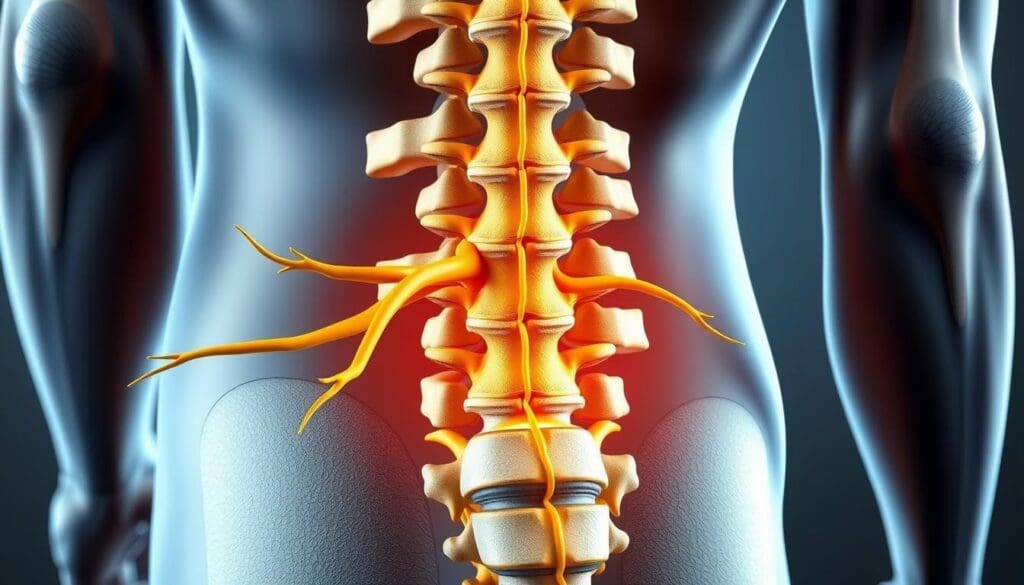Last Updated on November 26, 2025 by Bilal Hasdemir

Are you wondering if a cortisone shot can help your sciatica pain? At Liv Hospital, we know how tough sciatica can be. Sciatica pain runs from the lower back to the legs. It’s often caused by herniated discs, spinal stenosis, and piriformis syndrome. Do cortisone shots help sciatica? The ultimate guide to pain relief, effectiveness, and the surprising risks you need to know.
Cortisone injections are used to cut down inflammation in certain body parts. We look into the good and bad sides of cortisone shots for sciatica. This includes their pain relief and effectiveness.
Key Takeaways
- Cortisone shots are considered for managing sciatica-related pain when conservative treatments are ineffective.
- Corticosteroid injections aim to reduce inflammation in the affected areas.
- The effectiveness of cortisone shots varies among individuals.
- Potential risks and side effects are associated with cortisone injections.
- Understanding the benefits and risks is key for making informed decisions about sciatica treatment.
Understanding Sciatica: Causes and Symptoms

It’s important to know what causes and symptoms sciatica has. Sciatica is a sign of a deeper health problem. We need to find and fix the root cause.
Common Causes of Sciatic Nerve Pain
Sciatica happens when something irritates or presses on the sciatic nerve. Here are the main reasons:
- Herniated Discs: When the soft center of the disc leaks out, it can hurt nearby nerves.
- Spinal Stenosis: When the spinal canal gets too narrow, it can press on nerves, causing pain.
- Piriformis Syndrome: When the piriformis muscle presses on the sciatic nerve, it can cause pain.
- Spondylolisthesis: When a vertebra slips forward, it can squeeze the sciatic nerve.
Recognizing Sciatica Symptoms
Sciatica symptoms can differ from person to person. But common signs include:
| Symptom | Description |
| Radiating Pain | Pain that starts in the lower back and goes down one leg, following the sciatic nerve. |
| Numbness or Tingling | Feeling numb, tingling, or weak in the leg or foot. |
| Muscle Weakness | Feeling weak or tired in the leg or foot, making it hard to move or control. |
Spotting these symptoms is the first step to getting help. Knowing the causes and symptoms helps us find the best treatments. This might include using cortisone shots for pain relief.
What Are Cortisone Shots?

Cortisone shots are a common treatment for many inflammatory conditions, including sciatica. They aim to reduce inflammation and ease pain in the affected areas.
Composition and Mechanism of Action
Cortisone injections contain corticosteroids, which mimic cortisol, a hormone that fights inflammation. These corticosteroids suppress the immune system’s inflammation response. This reduces swelling and pain in the affected area.
The way cortisone shots work is fascinating. Corticosteroids bind to specific receptors. This action stops the production of pro-inflammatory cytokines and enzymes. This decrease in inflammation brings relief from pain.
Types of Corticosteroid Injections
There are several types of corticosteroid injections for treating inflammatory conditions like sciatica. The most common ones are:
- Triamcinolone
- Methylprednisolone
- Betamethasone
Each corticosteroid has unique properties and how long they last. The choice depends on the condition, inflammation level, and patient’s medical history.
It’s important to know about the different corticosteroid injections for sciatica. This knowledge helps healthcare providers find the best treatment for each patient.
Do Cortisone Shots Help Sciatica? Examining the Evidence
Cortisone shots for sciatica pain are a big topic for both patients and doctors. We look at the proof that cortisone shots help with sciatica. We focus on how well they work based on studies and what affects their success.
Success Rates and Clinical Studies
Studies show cortisone shots can help with sciatica pain for a short to medium time. About 60 to 75 percent of people see less pain after getting a shot. These results are good, but we need to know the study’s limits.
Studies differ in who they studied, how much cortisone was used, and how they measured success. Yet, most studies agree: cortisone shots can help with sciatica pain for a while.
Factors Affecting Treatment Outcomes
Many things can change how well cortisone shots work for sciatica. These include why the sciatica started, how well the shot was given, and the patient’s health.
Let’s look at what affects how well treatment works:
| Factor | Description | Impact on Outcome |
| Cause of Sciatica | Inflammatory vs. compressive causes | Inflammatory causes may respond better to cortisone |
| Accuracy of Injection | Precision in delivering cortisone to the affected area | Higher accuracy can lead to better outcomes |
| Patient Health | Presence of comorbidities, overall health status | Patients with fewer comorbidities may experience better relief |
Knowing these factors helps set realistic hopes and make smart choices about cortisone shots for sciatica. By looking at the evidence and each person’s situation, doctors and patients can find the best treatment plan.
How Cortisone Injections Target Sciatic Pain
Cortisone injections are a promising way to tackle sciatic pain. They aim to reduce inflammation around the sciatic nerve. This method is designed to tackle the pain at its source.
Inflammation Reduction Mechanism
Cortisone injections work by cutting down inflammation. Corticosteroids in these shots stop the body from making inflammatory chemicals. This action reduces swelling and pain, helping the area heal.
Targeted Delivery to Affected Areas
Another big plus of cortisone injections is how they deliver medicine directly to the affected area. They focus on the area around the sciatic nerve. This targeted method boosts treatment effectiveness and cuts down on side effects.
To wrap it up, cortisone injections fight sciatic pain in two ways. They reduce inflammation and deliver medicine right to the problem spots. This approach not only eases pain but also helps the area heal.
Cortisone Shot in the Buttocks for Sciatica: Specific Applications
Gluteal injections of cortisone are becoming a popular treatment for sciatica, mainly for those with piriformis syndrome. We’ll look into how these shots in the buttocks can help with sciatica caused by this condition.
Piriformis Syndrome and Gluteal Injections
Piriformis syndrome happens when the piriformis muscle presses on the sciatic nerve. This causes pain and discomfort. Cortisone shots can be given directly to the piriformis muscle to lessen inflammation and ease symptoms.
Research supports the use of gluteal injections for piriformis syndrome. It shows that corticosteroid injections can greatly reduce pain and improve function in those affected.
Technique and Precision Considerations
Administering cortisone shots in the buttocks needs precision and skill. The shot must be accurately aimed at the piriformis muscle for the corticosteroid to work well.
Healthcare providers use techniques like ultrasound guidance to place the injection correctly. This precision is key to getting the most benefit while avoiding side effects.
The following table summarizes key aspects of cortisone shots for piriformis syndrome:
| Aspect | Description | Benefit |
| Targeted Treatment | Cortisone shots directly into the piriformis muscle | Reduces inflammation and pain |
| Technique | Use of ultrasound guidance for precise injection | Ensures accurate delivery of corticosteroid |
| Clinical Evidence | Studies supporting the effectiveness of cortisone shots for piriformis syndrome | Provides a basis for treatment decisions |
Who Gives Cortisone Shots for Sciatica?
It’s important to know who gives cortisone shots for sciatica. These shots are a common way to treat sciatica pain. But, they need to be given carefully by someone with the right skills.
Medical Specialists Qualified to Administer Injections
Many medical specialists can give cortisone shots for sciatica. These include:
- Orthopedic Specialists: They know a lot about bones and muscles and can give these shots.
- Pain Management Specialists: They help with chronic pain and often give cortisone shots.
- Radiologists: They use imaging to guide the shots to the right spot.
- Physical Medicine and Rehabilitation (PM&R) Doctors: They help with chronic pain and use cortisone shots as part of treatment.
It’s key to pick a healthcare provider who is both qualified and has experience with these shots.
Choosing the Right Healthcare Provider
When picking a healthcare provider for cortisone shots, think about a few things:
| Criteria | Description | Importance Level |
| Specialization | Relevant specialty such as orthopedics or pain management | High |
| Experience | Number of cortisone injections administered | High |
| Patient Reviews | Feedback from previous patients | Medium |
| Facility Accreditation | Accreditation status of the treatment facility | High |
Looking at these factors can help you choose the right healthcare provider for cortisone shots.
It’s vital to make sure cortisone shots are given by a qualified person. This ensures they work well and are safe. Knowing who can give these shots and what to look for in a healthcare provider helps manage sciatica better.
The Procedure: What to Expect During a Cortisone Injection
The cortisone injection process is simple and involves several steps. These steps include preparation and post-injection care. Knowing what to expect can make patients feel more at ease.
Preparation and Administration
First, the healthcare provider will clean the injection site to prevent infection. Sometimes, a local anesthetic is used to numb the area. But this isn’t always needed.
The cortisone is then injected into the targeted area with a sterile needle. This part usually takes just a few minutes. The whole process, including getting ready, takes about 15 to 30 minutes.
The accuracy of the injection is key for its success. Guided injections use imaging like fluoroscopy or ultrasound. This ensures the cortisone goes exactly where it’s needed. This is very important for conditions like sciatica, where the area is deep.
Post-Injection Care and Recovery
After the injection, patients are watched for any immediate reactions. Most can go back to their usual activities right away. But, some might feel more pain or discomfort at the injection site. Ice can help with swelling and pain.
It’s best to avoid hard activities for a day or two. Your doctor might give you specific care instructions. They might also schedule follow-up visits to check how the treatment is working.
Learning about cortisone injections can ease worries and prepare patients. By understanding the steps from start to finish, patients can feel more confident about the treatment.
Timeline of Relief: When and How Long Cortisone Works
Knowing when and how long cortisone shots work is key. They’re often used to ease sciatica pain. But, how fast and long they work can change a lot.
Immediate vs. Delayed Effects
How quickly you feel better from cortisone shots can vary. Some people see relief right away, within hours. This fast relief comes from the shot’s anti-inflammatory effects, which quickly reduce swelling and nerve pressure.
But, others might not feel better until days later. This delay is because it takes time for the corticosteroid to fully work and for the inflammation to go down. Knowing this helps set the right expectations.
Duration of Pain Relief Benefits
How long cortisone shots keep pain away also varies. Relief might last weeks or months for some. The shot’s success depends on several things, like how bad the pain is and how well the shot was given.
A list of factors influencing the duration of relief includes:
- The specific corticosteroid used
- The location and accuracy of the injection
- The severity of the underlying condition
- Individual patient response
Doctors say, “The shot’s lasting relief depends on the corticosteroid’s strength and how it’s given.” Knowing these details helps both patients and doctors plan better treatments.
In short, cortisone shots can really help with sciatica pain. But, how fast and long they work can differ. Understanding this helps patients and doctors plan better treatments together.
Potential Side Effects and Risks of Steroid Injections
It’s important to know the side effects and risks of steroid injections. They are usually safe but can have some issues.
Common Side Effects
Common side effects include pain at the injection site, facial flushing, and trouble sleeping. These problems are usually short-lived and go away by themselves.
- Pain at the injection site
- Facial flushing
- Insomnia
Serious Complications and Risk Factors
Though rare, serious problems like infection, nerve damage, and tendon rupture can happen. Knowing these risks is key when thinking about steroid injections.
Long-term Concerns with Repeated Injections
Getting steroid injections too often can cause long-term issues like cartilage damage and osteoporosis. It’s important to manage how often and how many injections you get to avoid these problems.
Talking to a healthcare provider about the risks and benefits is a good idea. This way, you can make a smart choice about using steroid injections for sciatica pain.
When Cortisone Shots Don’t Work: Understanding Treatment Failures
Not everyone finds relief from cortisone shots for sciatica. This leaves some patients wondering what went wrong. Cortisone injections are a common treatment for sciatica pain. But, their success can vary.
Reasons for Ineffective Outcomes
Several factors can make cortisone shots for sciatica not work. These include:
- Incorrect Diagnosis: If the cause of sciatica is not correctly found, the shot may not help.
- Inadequate Dosing: The amount of cortisone might not be enough to reduce inflammation and pain.
- Presence of Other Underlying Conditions: Conditions like diabetes, infections, or other diseases can affect how well the shots work.
Knowing these reasons is key to figuring out what to do next.
Next Steps After Failed Injections
If a cortisone shot doesn’t help, there are other options to try:
| Treatment Option | Description |
| Physical Therapy | A customized exercise program to improve mobility and strengthen the back muscles. |
| Alternative Injection Therapies | Other types of injections, such as hyaluronic acid or platelet-rich plasma (PRP) injections, may be considered. |
| Surgical Consultation | In severe cases, surgical options may be explored to address the underlying cause of sciatica. |
It’s important to talk to a healthcare provider to find the best next steps.
By understanding why treatments fail and looking at other options, patients can work with their healthcare providers. Together, they can find an effective plan for managing sciatica pain.
Alternative Treatments for Sciatica Pain Management
If you have sciatica, looking into other treatments can help manage your pain. Cortisone shots are common, but there are other ways to find relief or add to your current treatment.
Conservative Non-Invasive Approaches
Non-invasive treatments aim to ease sciatica pain. Physical therapy is often suggested. It improves flexibility, strengthens muscles, and helps posture, which can lessen sciatic nerve pressure.
Acupuncture is also popular for chronic pain, including sciatica. It works by stimulating body points to reduce inflammation and aid healing.
Other Injection Therapies
There are more injection therapies than just cortisone shots for sciatica pain. Platelet-rich plasma (PRP) injections use your own platelets to heal the area. This method is being studied for sciatica treatment.
Prolotherapy and nerve blocks target specific pain spots. They offer alternatives to cortisone shots for some patients.
Surgical Options for Severe Cases
For severe sciatica not helped by other treatments, surgery might be needed. Procedures like microdiscectomy or laminectomy aim to relieve nerve pressure.
It’s key to talk to healthcare experts to find the best treatment. Exploring these options can lead to effective pain management tailored to your needs.
Conclusion: Making an Informed Decision About Cortisone for Sciatica
Thinking about cortisone shots for sciatica? It’s key to look at the good and the bad. Knowing how they work, their success rate, and possible side effects helps you decide.
We’ve looked into what causes sciatica, how cortisone shots work, and if they really help. For some, these shots can lessen pain by reducing swelling and hitting the right spots.
But, it’s also important to think about other treatments. This includes non-invasive methods and other types of injections. Talking to a doctor about these options can help find the best treatment for you.
Understanding all your treatment choices is vital when deciding on cortisone for sciatica. By weighing the pros and cons, you can manage your care better and get the best results.
FAQ
Will a cortisone shot help my sciatica?
Cortisone shots can help by reducing swelling around the sciatic nerve. But, how well they work depends on your sciatica’s cause and your health.
What are cortisone shots, and how do they work for sciatica?
Cortisone shots are injections of anti-inflammatory meds. They help by lessening swelling and pain around the sciatic nerve.
Can a cortisone shot in the buttocks help with piriformis syndrome?
Yes, shots in the buttocks can treat piriformis syndrome. They’re given to the piriformis muscle to reduce swelling and relieve nerve pressure.
Who can administer cortisone shots for sciatica?
Doctors like orthopedic specialists and pain management experts can give these shots. It’s important to choose a qualified doctor for safe and correct injections.
What are the possible side effects of cortisone shots for sciatica?
Side effects include pain and swelling at the site, and temporary high blood sugar. Rare but serious issues include infection, nerve damage, and allergic reactions.
How long does it take for cortisone shots to provide relief from sciatica?
Relief times vary. Some feel better right away, while others take days or weeks. Pain relief can last from weeks to months.
What if cortisone shots don’t work for my sciatica?
If shots don’t help, talk to your doctor about other options. This could include other injections, physical therapy, or surgery, based on your sciatica’s cause.
Are there alternative treatments for sciatica beside cortisone shots?
Yes, options include physical therapy, chiropractic care, and pain meds. Other treatments like PRP injections and surgery might also be considered.
Can I get repeated cortisone shots for ongoing sciatica?
Repeated shots are possible but carry risks like weakened tendons and bone thinning. Your doctor will guide you on the best treatment.
How do I prepare for a cortisone shot for sciatica?
Discuss your medical history and any allergies or meds with your doctor. You might need to stop certain meds beforehand. Your doctor will explain the procedure and what to expect.






